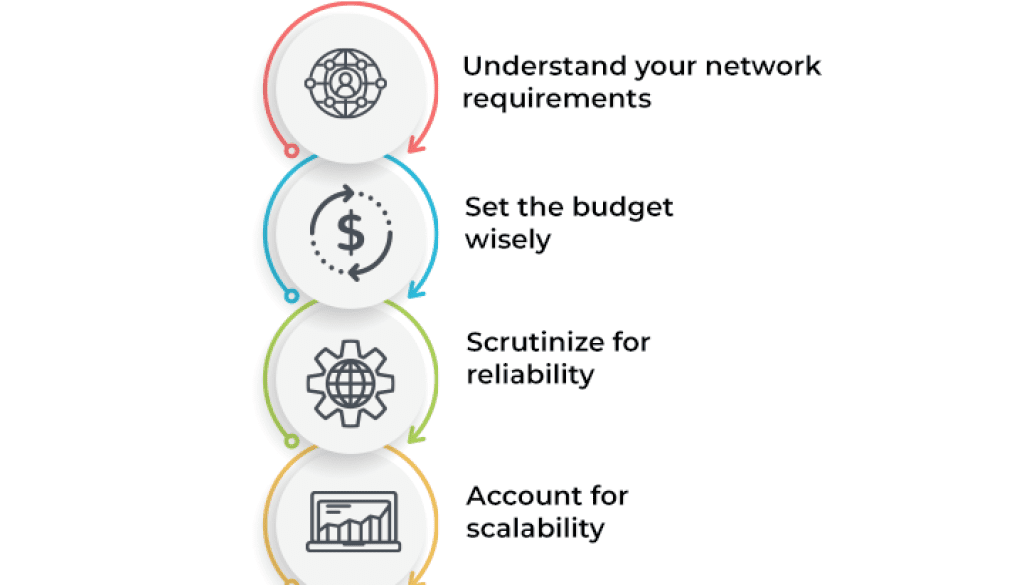What Is Network Topology? Definition, Types With Diagrams
In the intricate realm of computer networks, the term “network topology” refers to the arrangement of interconnected components that constitute a network. These components can include nodes, links, and various connecting media. The configuration of these elements, whether physical or logical, profoundly influences the network’s performance, reliability, and scalability.
Types of Network Topology
1. Point-to-Point Topology
Let’s delve deeper into the types of network topology, starting with Point-to-Point. This topology, also known as a dedicated link, involves a direct connection between two devices. It’s a straightforward approach, akin to a bridge connecting two islands. While simple, it’s ideal for smaller networks where direct communication suffices. However, its scalability is limited, making it less suitable for larger, more complex systems.

Read about: What is a VPN?| History of VPN
2. Bus Topology
Moving along our network exploration, Bus Topology presents itself as a shared communication line where all devices are connected. Picture it as a highway where data travels, accessible to all connected devices. While cost-effective and easy to implement, a drawback is that if the main “highway” fails, the entire network is affected.

3. Ring Topology
Enter Ring Topology, a circular arrangement where each device connects to exactly two other devices, forming a closed loop. Think of it as a chain of interconnected nodes. It ensures efficient data transfer, but a failure in one device can disrupt the entire chain, much like a broken link in a necklace.

4. Star Topology
Our journey brings us to Star Topology, where all devices connect to a central hub or switch. The hub acts as a traffic controller, managing data flow. Furthermore, this design offers easy management, and if one device fails, it doesn’t bring down the entire network. However, it hinges heavily on the central hub, making it a potential single point of failure.

5. Tree Topology
Combining elements of both star and bus topologies, Tree Topology forms a hierarchical structure. Like a family tree, it starts with a root node, branching out into multiple levels. This design provides scalability and can be expanded easily, though complexity increases as the network grows.

6. Mesh Topology
Mesh Topology introduces a dedicated connection between each device, creating a robust and redundant network. In addition, data can take multiple paths, ensuring reliability. While highly resilient, the implementation cost and complexity are significant, making it suitable for critical applications demanding high availability.

7. Hybrid Topology
Picture a fusion of different topologies working in harmony—that’s Hybrid Topology. It combines the strengths of two or more topologies to address specific network needs. For instance, integrating star and ring topologies to leverage their respective advantages.

8. Daisy Chain Topology
Lastly, Daisy Chain Topology involves connecting devices in a series, where one device links to the next and so on. It’s cost-effective but susceptible to failures, as a disruption in one device can affect the entire chain, akin to a string of holiday lights.

How To Choose a Topology for Your Network: Best Practices for 2022
Now that we’ve explored the diverse landscapes of network topology, let’s shift our focus to the crucial task of choosing the right topology for your network. This decision involves a strategic approach, considering various factors to ensure a robust and efficient network infrastructure.

1. Understand Your Network Requirements
The foundation of selecting an appropriate topology begins with a thorough understanding of your network requirements. Consider the size of your organization, the nature and volume of data traffic, and the specific needs of your users. A small office might thrive on a simple star topology, while a larger enterprise might require the resilience of a mesh network.
2. Set the Budget Wisely
Financial considerations play a pivotal role in shaping your network topology. While certain topologies may be cost-effective to implement initially, they might incur higher maintenance costs over time. Evaluate your budget constraints carefully, striking a balance between the initial investment and the long-term expenses associated with maintenance and upgrades.
3. Don’t Compromise on Reliability
Reliability is the bedrock of any successful network. The chosen topology should minimize the risk of network failures and ensure efficient data transmission. Consider factors like redundancy and fault tolerance—key elements that enhance the reliability of your network. A robust network topology should be resilient in the face of hardware failures or unexpected outages.
4. Account for Scalability
Your organization is dynamic, and your network should be able to grow with it. Scalability is a critical factor in network design. Select a topology that can accommodate your organization’s growth without necessitating a complete overhaul of the network infrastructure. Scalability ensures that your network remains efficient and responsive as your business expands.
Read about: What is Subnetting?|How it works?
5. Ensure Effective Implementation
Selecting the right topology is just the first step; the key to success lies in its effective implementation. Consider the skill set of your IT team, the availability of resources, and potential challenges during the implementation phase. Whether you’re setting up a new network or upgrading an existing one, a well-executed implementation is vital for the topology to function optimally.
Network Topology in Practice
To further illustrate the importance of network topology, let’s examine a real-world scenario. Consider a medium-sized business that experiences steady growth. In the initial stages, a star topology may be implemented due to its simplicity and ease of management. As the business expands, incorporating additional branches and remote offices, the network administrators may transition to a hybrid topology. This hybrid approach enables the organization to maintain centralized control while addressing the specific requirements of different departments or branches.
In contrast, a research institution dealing with large-scale data transfers and computational tasks may opt for a mesh topology. This ensures high redundancy and minimizes the risk of data loss during critical operations. The initial investment in implementing a mesh network may be higher, but the long-term benefits in terms of reliability and performance outweigh the costs.
Future Trends and Considerations
As we continue into the digital age, the landscape of networking is continuously evolving. Emerging technologies such as the Internet of Things (IoT), 5G connectivity, and edge computing introduce new considerations in network design. The increasing reliance on cloud services and the demand for real-time data processing further impact the choice of network topology.
In the coming years, we can anticipate an increased focus on decentralized and distributed architectures. Technologies like blockchain are challenging traditional centralized models, influencing how networks are structured and secured. Decentralized networks offer enhanced security, scalability, and transparency, redefining the criteria for selecting an appropriate topology.
Frequently Asked Questions (FAQs)
Q1: What is the main purpose of network topology?
A1: The main purpose of network topology is to define the physical or logical layout of interconnected devices within a network. It determines how data is transmitted, how devices communicate, and the overall efficiency and reliability of the network.
Q2: How does network topology impact network performance?
A2: Network topology directly influences network performance by determining how devices are connected and how data flows. The choice of topology can affect factors such as data transfer speed, reliability, and the ability to scale the network.
Q3: Is there a one-size-fits-all network topology?
A3: No, there is no one-size-fits-all network topology. The best topology for a specific organization depends on its unique requirements, budget constraints, and scalability needs. Different topologies offer different advantages, and the choice should align with the organization’s goals.
Q4: What is the role of scalability in network topology?
A4: Scalability is crucial in network topology because it ensures that the network can adapt and grow with the organization. The chosen topology should be able to accommodate an increase in devices, users, and data traffic without requiring a complete redesign of the network infrastructure.
Q5: How can I ensure effective implementation of the chosen topology?
A5: Effective implementation involves assessing the skill set of your IT team, ensuring adequate resources, and planning for potential challenges. Thoroughly understanding the chosen topology and following best practices during implementation will contribute to a successful deployment.
Conclusion
In conclusion, network topology serves as the architectural framework that defines how devices in a network are connected and communicate. The variety of topologies available allows organizations to tailor their network infrastructure to meet specific needs and challenges. Whether you opt for the simplicity of a star topology or the redundancy of a mesh network, the decision should align with your organization’s objectives and future growth plans.
As we step into 2022 and beyond, the landscape of networking continues to evolve. Emerging technologies, increased data demands, and the growing complexity of business operations underscore the importance of choosing the right network topology. By understanding the nuances of each topology type and adhering to best practices in selection and implementation, organizations can build a resilient, scalable, and future-ready network infrastructure that forms the backbone of their digital endeavors.
Reference
- Types of Network Topology
- Computer Network Topology: What It is and Types
- Types of Network Topology
- What is network topology and types of … – AfterAcademy
MCQs
1. What is the main purpose of network topology?
- A) To define the physical or logical layout of interconnected devices
- B) To determine the speed of data transfer
- C) To regulate internet connectivity
- D) To secure network connections
Answer: A) To define the physical or logical layout of interconnected devices
2. In which topology is a central hub or switch used to connect all devices?
- A) Ring Topology
- B) Mesh Topology
- C) Star Topology
- D) Bus Topology
Answer: C) Star Topology
3. Which topology provides high redundancy and is suitable for critical applications?
- A) Star Topology
- B) Mesh Topology
- C) Bus Topology
- D) Tree Topology
Answer: B) Mesh Topology
4. What is the potential drawback of a Bus Topology?
- A) High implementation cost
- B) Difficulty in management
- C) Single point of failure
- D) Limited scalability
Answer: C) Single point of failure
Some More
5. Which topology involves connecting devices in a series, forming a chain?
- A) Mesh Topology
- B) Daisy Chain Topology
- C) Star Topology
- D) Tree Topology
Answer: B) Daisy Chain Topology
6. What factor is crucial for effective network implementation?
- A) Redundancy
- B) High initial investment
- C) Skill set of the IT team
- D) Complexity of the network
Answer: C) Skill set of the IT team
7. Which trend is expected to gain prominence in future network architectures?
- A) Centralized models
- B) Decentralized and distributed architectures
- C) Ring Topology
- D) Bus Topology
Answer: B) Decentralized and distributed architectures
8. What does scalability in network topology refer to?
- A) The physical size of the network
- B) The ability of the network to adapt and grow
- C) The number of devices connected
- D) The speed of data transfer
Answer: B) The ability of the network to adapt and grow
9. Which topology combines the strengths of two or more topologies?
- A) Hybrid Topology
- B) Mesh Topology
- C) Star Topology
- D) Ring Topology
Answer: A) Hybrid Topology
10. What does a Ring Topology ensure for data transfer?
- A) High redundancy
- B) Efficient data transfer
- C) Centralized control
- D) Direct communication between devices
Answer: B) Efficient data transfer



